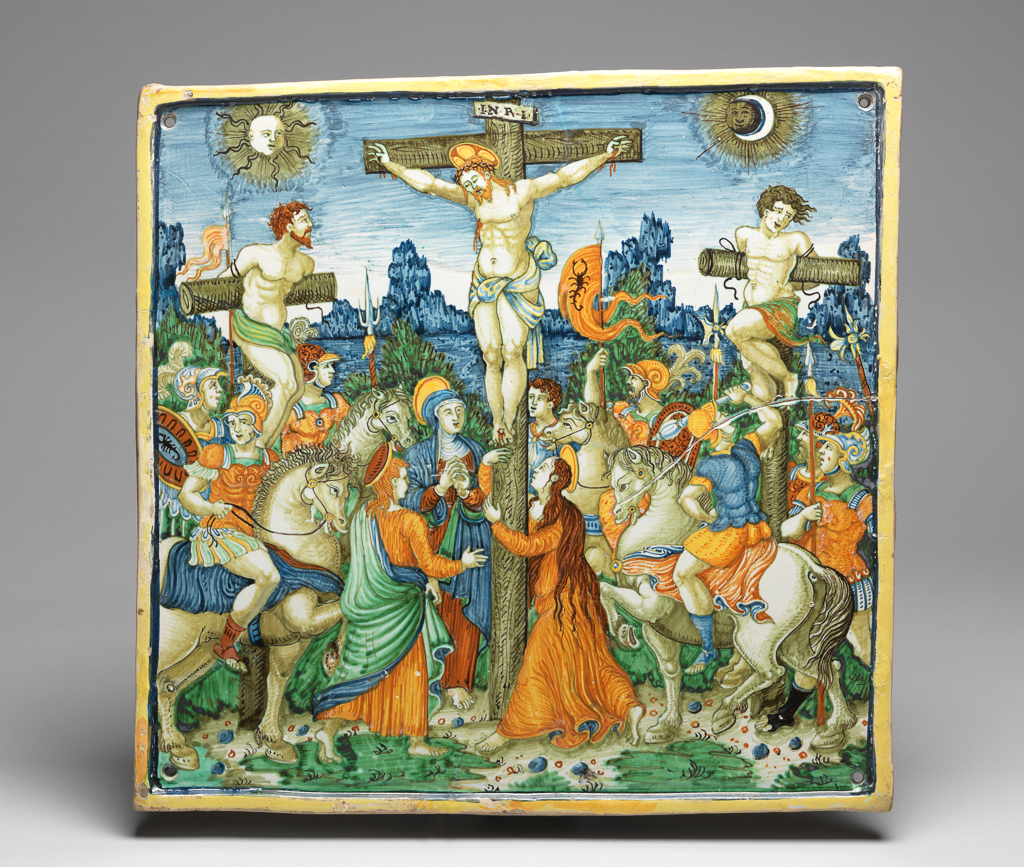Current Location: In storage
Titles
The Crucifixion
Maker(s)
Pottery:
Mancini Workshop
Painter:
Mancini, Giacomo
(Probably)
Entities
Categories
Description
Maiolica panel painted in polychrome with the Crucifixion.
Buff earthenware, tin-glazed on the front and outside edges; reverse unglazed. Painted in blue, green, yellow, orange, brown, stone, and manganese-purple. Square with a raised edge and a suspension hole in each corner.
The Crucifixion. The Cross is in the centre, with Mary Magdalene at its foot and the Virgin and St John to the left, surrounded by Roman cavalry and foot soldiers. A soldier on the left holds a shield charged with a scorpion, and another to the right of the Cross holds a scorpion standard. The crosses of the two malefactors are further back. In the sky above them is the sun on the left, and the moon on the right. The raised edge is yellow. The back is inscribed in greyish-black: 'DIRVTI/ISSVI'.
Notes
History note: Unknown before testator, Charles Brinsley Marley (1831-1912)
Legal notes
C.B. Marlay Bequest
Measurements and weight
Depth: 2.5 cm
Height: 40 cm
Width: 41.3 cm
Acquisition and important dates
Method of acquisition: Bequeathed
(1912)
by
Marlay, Charles Brinsley
Dating
16th Century, third quarter
Renaissance
Production date:
dated
AD 1556
: the inscription in a mixture of arabic and Roman numerals appears to be 1556
Note
This panel is one of the most ambitious examples of istoriato maiolica from Deruta. It is attributed to Giacomo Mancini, known as 'El Frate' (the Friar), who was the most significant exponent of istoriato decoration there in the mid sixteenth century. He was recorded as a painter in 1540, and several lustred and polychrome dishes signed by him between 1541 and 1545 survive and these have enabled others to be attributed to him. By the 1550s his style had matured but several characteristics of his hand remained constant, providing links with his earlier work. One of the most noticeable was his treatment of horses' heads and ears, which can be seen clearly on this panel, as can the tousled hair which many of his figures have. Some of his finest work was done in the 1560s, such as a large dish decorated with Parnassus, dated 1564, in the Musée Alexis-Forel at Morges. He died in or shortly before 1581 when his sons divided the family goods between them.
This Crucifixion may have been influenced by two prints, both of which include horses: a Calvary, by a follower of Marcantonio Raimondi and another dated 1541, probably after Francesco Salviati. The sun and moon are shown to express the mourning of the whole universe at Christ's death. The scorpions on the banner and on one shield conventionally that the holders were sinners. They were also symbols of treachery, and therefore also refer to the betrayal of Christ by Judas.
The holes in each corner indicate that it was intended to be attached to a wall.
School or Style
Renaissance
People, subjects and objects depicted
Components of the work
Decoration
composed of
high-temperature colours
( blue, green, yellow, orange, brown, stone, and manganese-purple)
tin-glaze
Suspension Holes
Materials used in production
Earthenware
Inscription or legends present
- Text: DIRVTI/ISSVI
- Location: On back
- Method of creation: Painted in greyish-black
References and bibliographic entries
Related exhibitions
Identification numbers
Accession number: MAR.C.57-1912
Primary reference Number: 48588
Stable URI
Audit data
Created: Saturday 6 August 2011
Updated: Tuesday 30 April 2024
Last processed: Wednesday 14 May 2025
Associated departments & institutions
Owner or interested party:
The Fitzwilliam Museum
Associated department:
Applied Arts

 IIIF Manifest
IIIF Manifest





